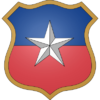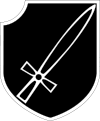Siege of San Salvador
The Siege of San Salvador (Creeperian Spanish – Creeperian: Սիտո ել Սան Սալվադոր; Creeperian Spanish – Iberic: Sito de San Salvador), also referred to as the Battle of San Salvador (Creeperian: Բատաժա ել Սան Սալվադոր; Iberic: Batalla de San Salvador), and known in modern-Creeperopolis as The Siege (Creeperian: Ել Սիտո; Iberic: El Sito), was the largest, lengthiest, and deadliest confrontation of the Creeperian Civil War between the Catholic Imperial Restoration Council (Imperial Council) and the National Council for Peace and Order (National Council). The battle was fought mostly within the department of San Salvador, one of the most strategically and symbolically important regions of the country. Due to its large and complicated nature, the siege has sometimes been considered to be its own war within the Creeperian Civil War.
The siege began in May 1946 with an initial attack by the National Council against forces of the Imperial Council. The National Council's failure to win a quick and decisive victory over the Imperial Council led to a stalemate and long-lasting siege, as neither side was able to break through the other's defenses. A final offensive by the Imperial Council in August 1949 forced a National Council retreat, ending the siege in a decisive Imperial Council victory. The civil war itself would later end on 30 September 1949.
Contents
Background
Failure of the Papal War
Imperial Council advances in the north
Prelude
Planning and organization
Final preparations
Order of battle
National Council order of battle
The commanders-in-chief of the National Council forces in the Siege of San Salvador were Emperors Miguel VII and Marcos I while its overall military commanders were Chief Field Marshals Juan Salinas Figueroa and Miguel Salinas Ortega.
- North–Lake San Salvador front
Army Group Mauricio Tasis Quesada – Field Marshal José Bolívar Aguirre
- 3rd Army – General Rigoberto Fernán Tasis
- 9th Army – General Ricardo Rosales Román
- 4th Infantry Division (Terranilian) – Major General Adam Gát
- 2nd Flotilla – Admiral Lorenzo Sarmiento Elvira
- 25th Air Force Wing – General Antonio Morterero Nores
- East–central San Salvador front
Army Group Qarl Marx – Field Marshal Miguel Salinas Ortega
- 1st Army – General Alan Hurtado Ros
- 11th Army – General Rubén Alguacil Prats
- 28th Air Force Wing – General Sebastián Pousa Frexia
- South–Volcano San Salvador front
Army Group Joel Lacasa Campos – Field Marshal Pascual Espinar Casaus
- 7th Army – General Pedro Morillo Coronil
- 8th Army – General Antonio Yon Sosa
- 27th Air Force Wing – General Dídac Pareja Campos
- Paramilitaries (various fronts)
- Atheist Red Army – General Secretary Mariano Alcocer Fraga
- National Guard – Chief Guard Ángel Moruga Leoz
- Special Task Squadrons – General José Huerta Milano
Imperial Council order of battle
The commanders-in-chief of the Imperial Council forces in the Siege of San Salvador were Emperors Romero I and Romero II while its overall military commander was Chief Field Marshal Alfonso Cabañeras Moreno.
- North–Lake San Salvador front
Army Group King Saint Miguel I – Field Marshal Juan Primavera Sánchez
- 3rd Army – General Agustín Sarmiento Cruz
- 11th Army – General Héctor Carballo Lain
- 16th Flotilla – Admiral David Cortés Andino
- 3rd Air Force Wing – General Rolando Dávalos Abasto
- East–central San Salvador front
Army Group Emperor Adolfo III – Field Marshal Máximo Barrueco Morterero
- 1st Army – General Vicente Capmany Fraga
- 1st Infantry Division – Lieutenant General Milans Bosch Ussía
- 5th Infantry Division – Lieutenant General Emmanuel Guillén Rubio
- 8th Infantry Division – Lieutenant General Eduardo López López
- 9th Infantry Division – Lieutenant General Adrián Cavallería Martí
- 13th Infantry Division – Lieutenant General Óliver Sanz Yepes
- 16th Infantry Division – Lieutenant General José Miralles Tamayo
- 17th Infantry Division – Lieutenant General José Berganza Espiga
- 18th Infantry Division – Lieutenant General Juan Alcabú Obregón
- 23rd Infantry Division – Lieutenant General Francisco Cortéz Ureña
- 29th Infantry Division – Lieutenant General Jesús Tafalla Mancebo
- 2nd Army – General Aaron Chicote Villa
- 4th Air Force Wing – General Pablo Piñón Ureña
- South–Volcano San Salvador front
Army Group King Saint Alfonso I – Field Marshal Jorge Díaz Molina
- 5th Army – General Miguel Saelices Cabal
- Lyoan Volunteer Legion – Colonel Manima Lama
- 9th Army – General Xavier Dávalos Carita
- 7th Air Force Wing – General Aarón Tafalla Rubio
- Paramilitaries (various fronts)
- Creeperian People's Catholic Front – General Alexander Sánchez Molina
- Camisas Negras – Caudillo Carlos Hernández Videla
- Falange Creeperiano – Captain Óscar Únzaga Vega
- Imperial Guard – Chief Guard Gerardo Aguinaldo Villacrés
- Militarist Nationalist Front – General Adolfo Rivera López
Course of the siege
1946
1947
1948
1949
Aftermath
Consequences of the remainder of the war
Casualties
Imperial Council casualties
National Council casualties
Civilian casualties
Commemoration
In popular culture
Literature
Books
- Guerra Civil (2009) by Orlando Pareja Palau
- La'Batalla de San Salvador (1972) by Carlos López Inéz
- La'Segunda Cruzada (1995) by Francisco Bermúdez Castro
- Por'el Amor a la'Patria (2005) by Javíer Tejón Molina
Films and documentaries
Monuments
Poetry
- Legal poetry
- La'Guerra Final del Romeristo
- La'Lucha Santo por'Dios
- La'Vida deun Romeristo
- San Salvador es Nuestro
- Siempre Lucha por la'Patria
- Illegal poetry
See also
External links
- Battle of San Salvador (NSIndex; 20 September 2019)
- Siege of San Salvador (IIWiki; 20 January 2020)
- Articles with short description
- Use dmy dates from February 2022
- Use Jackian from February 2022
- All LCNWiki articles written in Jackian
- Flagdeco with missing country data templates
- Pages with broken file links
- Creeperopolis
- Creeperopolis RP
- Creeperopolis Terraconserva
- Terraconserva
- Battles
- Creeperian Civil War
- Creeperian Conflicts
- New Gandor
- Terranihil
- Lyoa
- Siege of San Salvador











